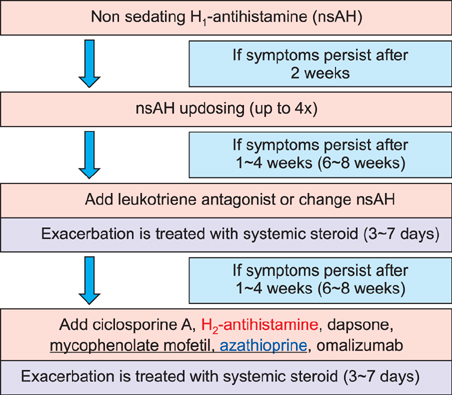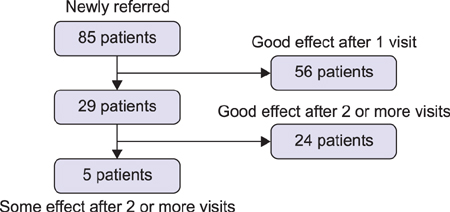Ann Dermatol.
2014 Feb;26(1):73-78. 10.5021/ad.2014.26.1.73.
A Case Series Study of Eighty-Five Chronic Spontaneous Urticaria Patients Referred to a Tertiary Care Center
- Affiliations
-
- 1Department of Dermatology, Aarhus University Hospital, Aarhus, Denmark. chr-vest@post9.tele.dk
- KMID: 2265700
- DOI: http://doi.org/10.5021/ad.2014.26.1.73
Abstract
- BACKGROUND
Chronic spontaneous urticaria is a debilitating disease for the patients and often considered by the doctors a very difficult disease to treat. In 2009 the European Academy of Allergy and Clinical Immunology/Global Allergy and Asthma European network/European Dermatology Forum/World Allergy Organization (EAACI/GA2LEN/EDF/WAO) published a revised version of the guidelines for the treatment of urticaria which included an algorithm for the treatment.
OBJECTIVE
The objective of this study was to examine the clinical effect and the practical use of the algorithm.
METHODS
The study was performed as a case-series study of all newly referred patients to our urticaria clinic over a period of 18 months.
RESULTS
Our results show that the single most important and efficient treatment of urticaria patients is up dosing non-sedating antihistamines as recommended by the EAACI/GA2LEN/EDF/WAO guidelines. We did not find any predicting factors for responders to the antihistamine treatment, but about one third of the patients did not respond to the up-dosing of the antihistamines.
CONCLUSION
Antihistamines seems to be the most efficient treatment for urticaria; other treatments such as montelukast, azathioprine, and mycophenolate mofetil may also be used, but only in combination with antihistamines and only in the case of an independent antihistamines treatment failure. The EAACI/GA2LEN/EDF/WAO guideline for the treatment of urticaria offers an efficient and simple guidelines for the treatment of urticaria.
MeSH Terms
Figure
Reference
-
1. Grob JJ, Revuz J, Ortonne JP, Auquier P, Lorette G. Comparative study of the impact of chronic urticaria, psoriasis and atopic dermatitis on the quality of life. Br J Dermatol. 2005; 152:289–295.
Article2. O'Donnell BF, Lawlor F, Simpson J, Morgan M, Greaves MW. The impact of chronic urticaria on the quality of life. Br J Dermatol. 1997; 136:197–201.3. Maurice-Tison S, Pouyanne J, Doutre MS. General practitioners, dermatologists, allergists, and the management of chronic urticaria. Results of a practice survey. Ann Dermatol Venereol. 2003; 130:1S160–1S173.4. Grattan C. The urticarias: pathophysiology and management. Clin Med. 2012; 12:164–167.
Article5. Zuberbier T, Asero R, Bindslev-Jensen C, Walter Canonica G, Church MK, Giménez-Arnau A, et al. Dermatology Section of the European Academy of Allergology and Clinical Immunology. Global Allergy and Asthma European Network. European Dermatology Forum. World Allergy Organization. EAACI/GA(2)LEN/EDF/WAO guideline: definition, classification and diagnosis of urticaria. Allergy. 2009; 64:1417–1426.
Article6. Zuberbier T, Asero R, Bindslev-Jensen C, Walter Canonica G, Church MK, Giménez-Arnau AM, et al. Dermatology Section of the European Academy of Allergology and Clinical Immunology. Global Allergy and Asthma European Network. European Dermatology Forum. World Allergy Organization. EAACI/GA(2)LEN/EDF/WAO guideline: management of urticaria. Allergy. 2009; 64:1427–1443.7. Grattan CE, Sabroe RA, Greaves MW. Chronic urticaria. J Am Acad Dermatol. 2002; 46:645–657.
Article8. Zuberbier T, Maurer M. Urticaria: current opinions about etiology, diagnosis and therapy. Acta Derm Venereol. 2007; 87:196–205.9. Wedi B, Kapp A. Evidence-based therapy of chronic urticaria. J Dtsch Dermatol Ges. 2007; 5:146–157.
Article10. Weller K, Viehmann K, Bräutigam M, Krause K, Siebenhaar F, Zuberbier T, et al. Cost-intensive, time-consuming, problematical? How physicians in private practice experience the care of urticaria patients. J Dtsch Dermatol Ges. 2012; 10:341–347.
Article11. Weller K, Schoepke N, Krause K, Ardelean E, Bräutigam M, Maurer M. Selected urticaria patients benefit from a referral to tertiary care centres--results of an expert survey. J Eur Acad Dermatol Venereol. 2013; 27:e8–e16.12. Staevska M, Popov TA, Kralimarkova T, Lazarova C, Kraeva S, Popova D, et al. The effectiveness of levocetirizine and desloratadine in up to 4 times conventional doses in difficult-to-treat urticaria. J Allergy Clin Immunol. 2010; 125:676–682.
Article13. Ivyanskiy I, Sand C, Thomsen SF. Omalizumab for chronic urticaria: a case series and overview of the literature. Case Rep Dermatol. 2012; 4:19–26.
Article14. Kulthanan K, Jiamton S, Thumpimukvatana N, Pinkaew S. Chronic idiopathic urticaria: prevalence and clinical course. J Dermatol. 2007; 34:294–301.
Article15. Toubi E, Kessel A, Avshovich N, Bamberger E, Sabo E, Nusem D, et al. Clinical and laboratory parameters in predicting chronic urticaria duration: a prospective study of 139 patients. Allergy. 2004; 59:869–873.
Article
- Full Text Links
- Actions
-
Cited
- CITED
-
- Close
- Share
- Similar articles
-
- A Long Term Case Series Study of the Effect of Omalizumab on Chronic Spontaneous Urticaria
- Dermographism ( III ): Dermographism in Acute and Chronic Urticaria
- Treatment with biological products for chronic urticaria
- Clinical Predictors of Disease Progression in New-Onset Urticaria
- Omalizumab on Chronic Spontaneous Urticaria and Chronic Inducible Urticaria: A Real-World Study of Efficacy and Predictors of Treatment Outcome



